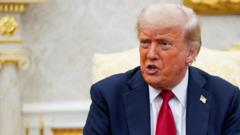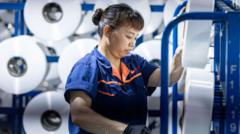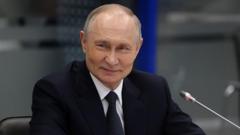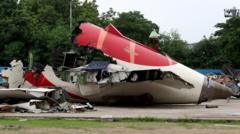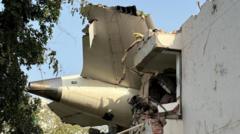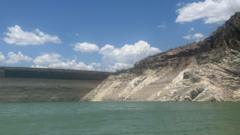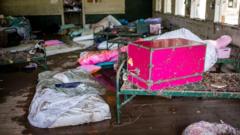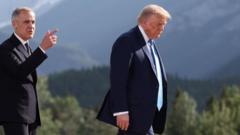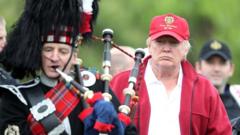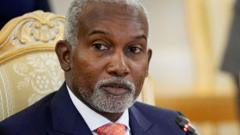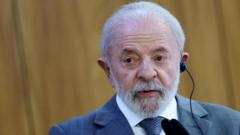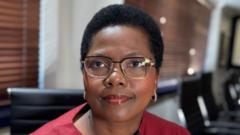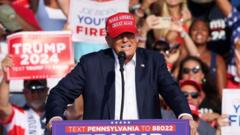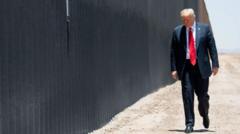Amid ongoing debates on Air Force One's features and a prospective Qatari gift, we delve into the aircraft's present state and future enhancements, introduced by multiple perspectives.
**A Transformative Future for Air Force One: Inside the Presidential Jet and Qatari Offer**
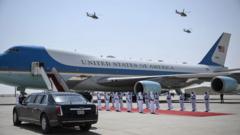
**A Transformative Future for Air Force One: Inside the Presidential Jet and Qatari Offer**
As discussions of a lavish Qatari gift shape the future of Air Force One, we explore its current features and the implications of such a change.
In recent discussions regarding Air Force One, the iconic presidential jet, contrasting views have emerged following Qatar's offer to gift a new 747-8, potentially transforming the aircraft used by the U.S. president. Currently, journalists accompanying the president typically have limited interaction with the aircraft's interior, relegated to a small press cabin at the rear, while access to the presidential suite at the front involves security measures.
During a recent trip to the Middle East, where international air transport remains a hot topic, Fox News host Sean Hannity was granted exclusive access for an in-flight interview, illustrating the disparity between media access and the president's privileges. The press cabin, featuring 14 comfortable seats, a bathroom, and snack options including unique Air Force One-branded M&Ms, offers a first-class flying experience, with meals served on longer flights.
However, the potential for a dramatic overhaul looms as former President Donald Trump expresses interest in Qatar's lavish offer, seen as the largest foreign gift to a U.S. president in history. Traditionally, "Air Force One" denotes any aircraft carrying the president, but the public's image typically aligns with the 747-200B, known for its distinctive color scheme designed by Jackie Kennedy in 1962. With aging aircraft now in use since 1990, maintenance costs are rising, prompting Trump to voice frustration regarding their outdated technology.
Trump's desire for an updated aircraft has intensified, especially since the planned order for new Boeing models has faced delays. While he had previously selected a different livery for the upcoming jets, they may not be delivered during his second term, which spurs interest in Qatar's offer of a refurbished 747. Visiting the aircraft earlier this year, Trump is not only considering its visual appeal but also the practical implications of converting a foreign jet into a presidential vehicle.
Challenges associated with the retrofitting process include ensuring high-level communications and security systems, as well as adapting the interior layout. Experts note that retrofitting could be a time-consuming and costly enterprise, potentially running into a billion dollars, and might stretch year into the future. Nevertheless, some analysts suggest that Trump, as president, could bypass certain modifications.
The retirement of the current 747s will mark the end of an era filled with significant historical moments and journeys of multiple presidents since Bill Clinton. Notably, the aircraft played a crucial role during the 9/11 attacks, enabling President George W. Bush to remain airborne until it was deemed safe to land.
Despite its aging state, Air Force One remains a potent symbol of presidential authority and military might, serving functional purposes beyond luxury. As discussions unfold around its future, the narrative continues to reflect varied perspectives on governance, security, and public sentiment.
During a recent trip to the Middle East, where international air transport remains a hot topic, Fox News host Sean Hannity was granted exclusive access for an in-flight interview, illustrating the disparity between media access and the president's privileges. The press cabin, featuring 14 comfortable seats, a bathroom, and snack options including unique Air Force One-branded M&Ms, offers a first-class flying experience, with meals served on longer flights.
However, the potential for a dramatic overhaul looms as former President Donald Trump expresses interest in Qatar's lavish offer, seen as the largest foreign gift to a U.S. president in history. Traditionally, "Air Force One" denotes any aircraft carrying the president, but the public's image typically aligns with the 747-200B, known for its distinctive color scheme designed by Jackie Kennedy in 1962. With aging aircraft now in use since 1990, maintenance costs are rising, prompting Trump to voice frustration regarding their outdated technology.
Trump's desire for an updated aircraft has intensified, especially since the planned order for new Boeing models has faced delays. While he had previously selected a different livery for the upcoming jets, they may not be delivered during his second term, which spurs interest in Qatar's offer of a refurbished 747. Visiting the aircraft earlier this year, Trump is not only considering its visual appeal but also the practical implications of converting a foreign jet into a presidential vehicle.
Challenges associated with the retrofitting process include ensuring high-level communications and security systems, as well as adapting the interior layout. Experts note that retrofitting could be a time-consuming and costly enterprise, potentially running into a billion dollars, and might stretch year into the future. Nevertheless, some analysts suggest that Trump, as president, could bypass certain modifications.
The retirement of the current 747s will mark the end of an era filled with significant historical moments and journeys of multiple presidents since Bill Clinton. Notably, the aircraft played a crucial role during the 9/11 attacks, enabling President George W. Bush to remain airborne until it was deemed safe to land.
Despite its aging state, Air Force One remains a potent symbol of presidential authority and military might, serving functional purposes beyond luxury. As discussions unfold around its future, the narrative continues to reflect varied perspectives on governance, security, and public sentiment.

